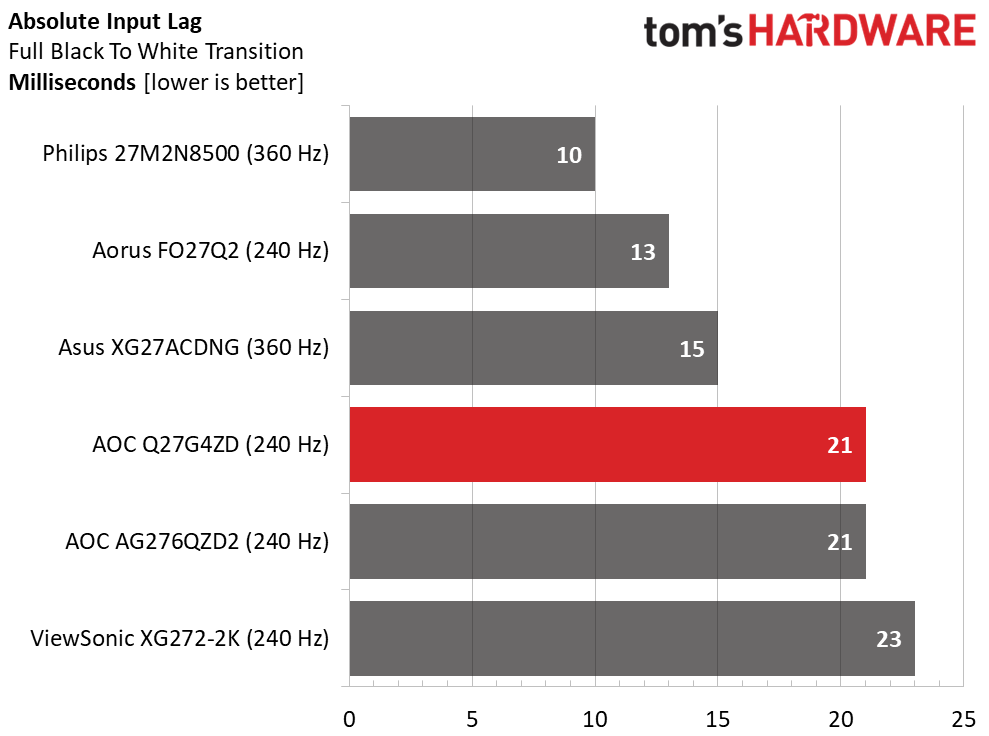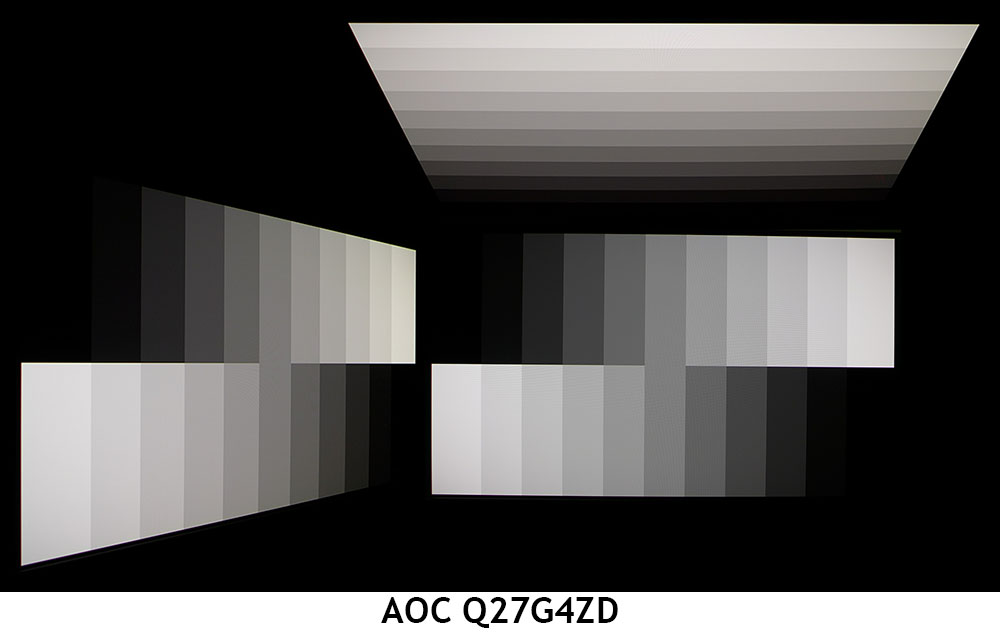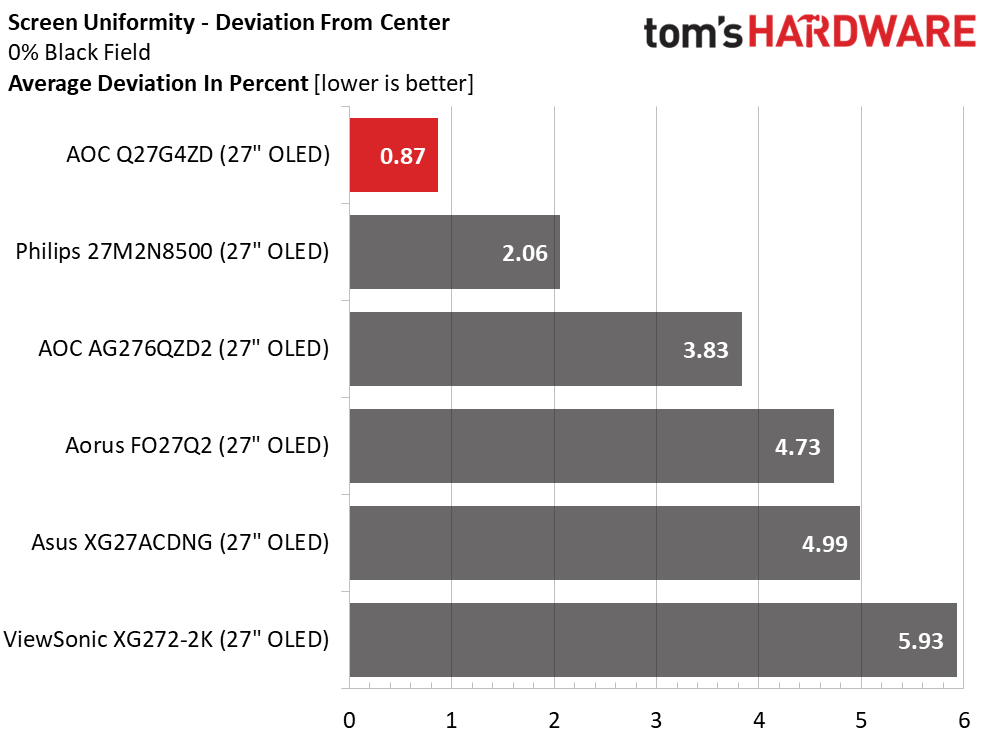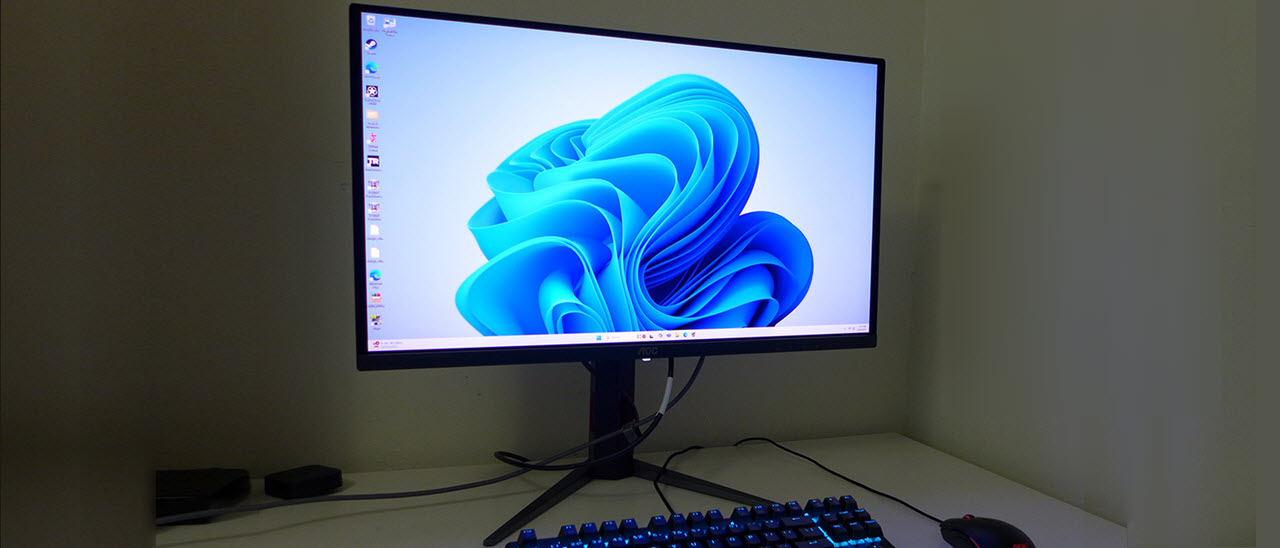Why you can trust Tom's Hardware
The 27-inch QHD OLED category is well stocked with 240 and 360 Hz screens. To compare the Q27G4ZD’s performance, I’ve rounded up Asus’ XG27ACDNG, Philips 27M2N8500, Aorus’ FO27Q2, ViewSonic’s XG272-2K, and another AOC, the AG276QZD2.
Pixel Response and Input Lag
Click here to read up on our pixel response and input lag testing procedures.


I’ve observed that once you run at 240 Hz or faster, there is no visible difference in motion resolution between OLED screens of the same size and pixel density. This means 360 Hz won’t be any smoother than 240. The group tracks consistently here with 4ms for the 240s and 3ms for the 360s.
The difference happens in the input lag test, where the 360 Hz screens have a clear advantage, unless you’re running the Aorus FO27Q2, which smokes this test at 13ms. The Philips is the fastest QHD OLED currently available, so that’s worth considering. But the Q27G4ZD is the best of the rest at 21ms. For all but the most skilled gamers, this is more than enough performance. I do not perceive any input lag when playing on it.
Test Takeaway: The Q27G4ZD doesn’t cut any corners in gaming performance. It’s just as smooth and responsive as more expensive OLEDs, regardless of resolution or refresh rate. With 21ms of total input lag, it isn’t the very fastest panel, but it is more than fast enough for all but the most skilled competitors. And for the money, it doesn’t get better.
Viewing Angles

I’ve noted slight color shifts in other QD-OLED monitors but the Q27G4ZD barely looks any different at 45 degrees to the side. It is a tad warmer but less so than I’ve seen before. And there is no change to brightness or gamma, which is typical of all OLEDs. The top view has slightly reduced gamma but again, there is almost no change in color. This is excellent performance.
Screen Uniformity
To learn how we measure screen uniformity, click here.
Get Tom's Hardware's best news and in-depth reviews, straight to your inbox.

The Q27G4ZD is officially the most uniform screen I’ve ever tested. The only other monitors that come close to 0.87% are premium reference panels costing upward of $3,000. Though I find any result under 10% to be visually perfect, I noted a higher visible uniformity when observing gray field patterns of 5 and 10%. Though every sample will be slightly different, you can expect a great-looking screen from the Q27G4ZD.
MORE: Best Gaming Monitors
MORE: How We Test PC Monitors
MORE: How to Buy a PC Monitor
Current page: Response, Input Lag, Viewing Angles and Uniformity
Prev Page Features and Specifications Next Page Brightness and Contrast
Christian Eberle is a Contributing Editor for Tom's Hardware US. He's a veteran reviewer of A/V equipment, specializing in monitors. Christian began his obsession with tech when he built his first PC in 1991, a 286 running DOS 3.0 at a blazing 12MHz. In 2006, he undertook training from the Imaging Science Foundation in video calibration and testing and thus started a passion for precise imaging that persists to this day. He is also a professional musician with a degree from the New England Conservatory as a classical bassoonist which he used to good effect as a performer with the West Point Army Band from 1987 to 2013. He enjoys watching movies and listening to high-end audio in his custom-built home theater and can be seen riding trails near his home on a race-ready ICE VTX recumbent trike. Christian enjoys the endless summer in Florida where he lives with his wife and Chihuahua and plays with orchestras around the state.
-
Skip27 The best advice I ever received was not to upgrade your monitor until you are ready to NEED high-end monitors. I used a wonderful 27' Asus for over a decade, and it was great, but when I replaced it with my current 31.5' Dell, I intentionally went 60hz because I do not want to be the kind of guy who thinks a $470 monitor is "cheap." You never get impressed with a better monitor, but once you use one for long enough, anything less feels garbage. The same is true with graphics cards. I never go over the x70 nvidia cards because I do not want to drop a grand every year. I have a 4060ti right now, and it is good enough. My next card will likely be AMD, but it will not cost over $500. Recklessly increasing one's standards gets needlessly expensive.Reply
That said, I hope this Dell will be as tough as my old Asus. That monitor took a beating and it still works, although light bleed started to get our of control in the corners. -
Mindstab Thrull The big benefit of this AOC is that it's a solid monitor under 500 USD - which means that other companies are going to have to take notice that there's an OLED encroaching on "great VA/IPS/etc" territory.Reply
I hope this means that in Canada, maybe in another year or two we can get OLED's under 500 CAD - which at current exchange rate is about 350 USD. I will be ecstatic when that happens!
Mindstab Thrull
Nomming ur sanities since 1837 BSE (Before the Sarpadian Empires)
